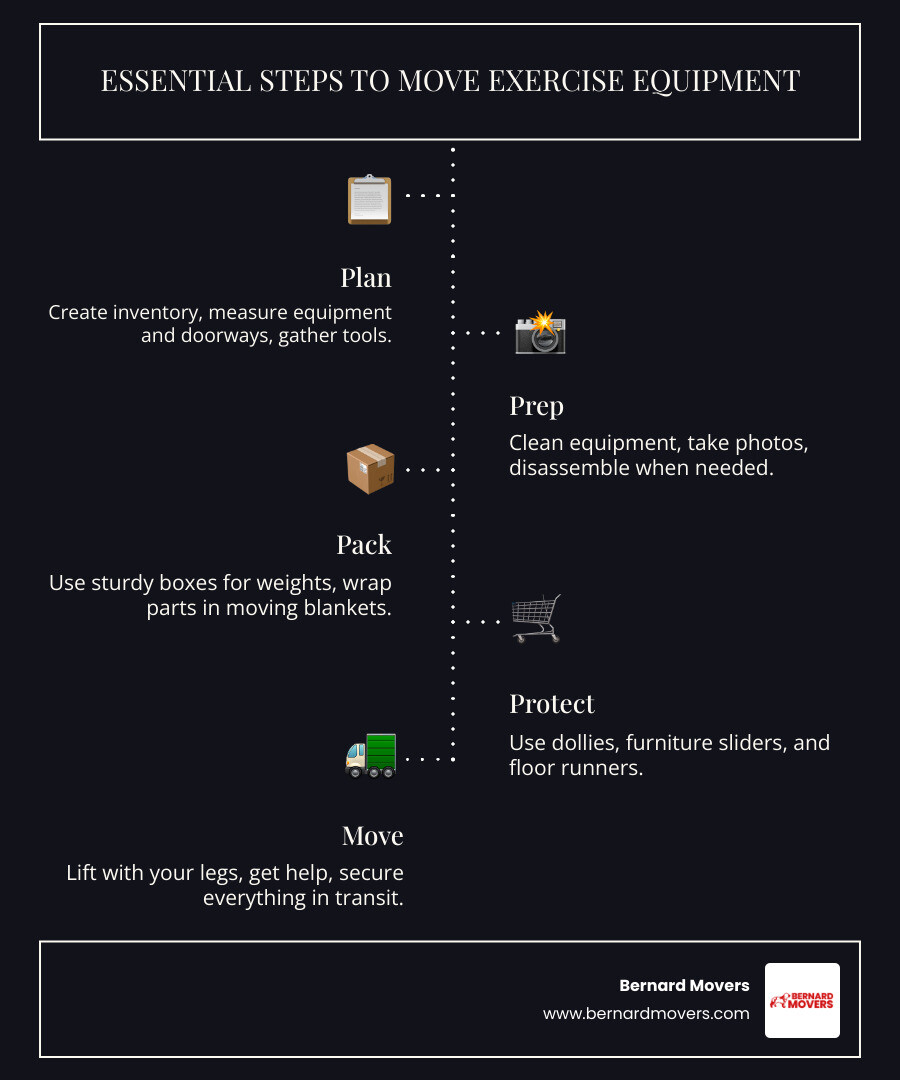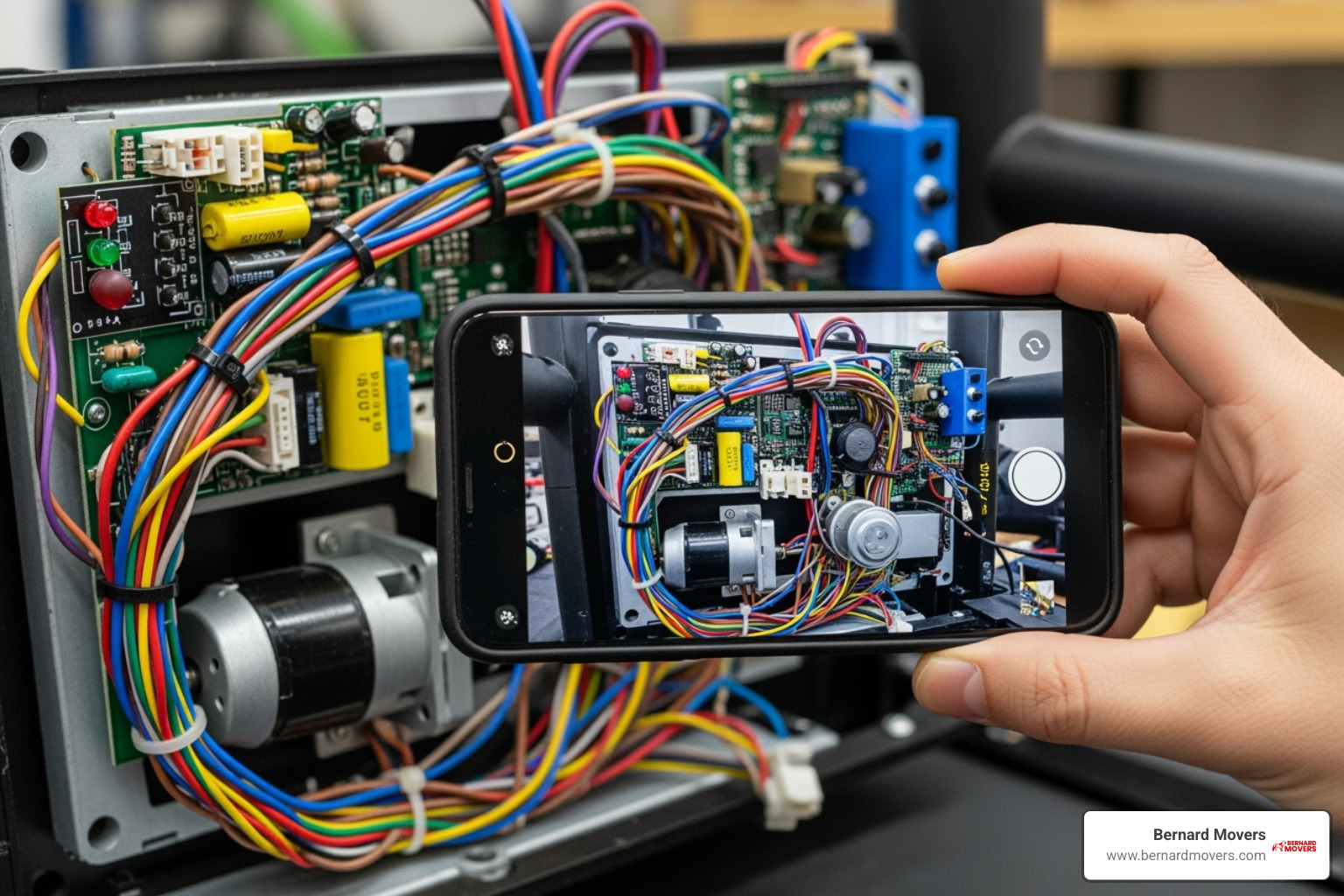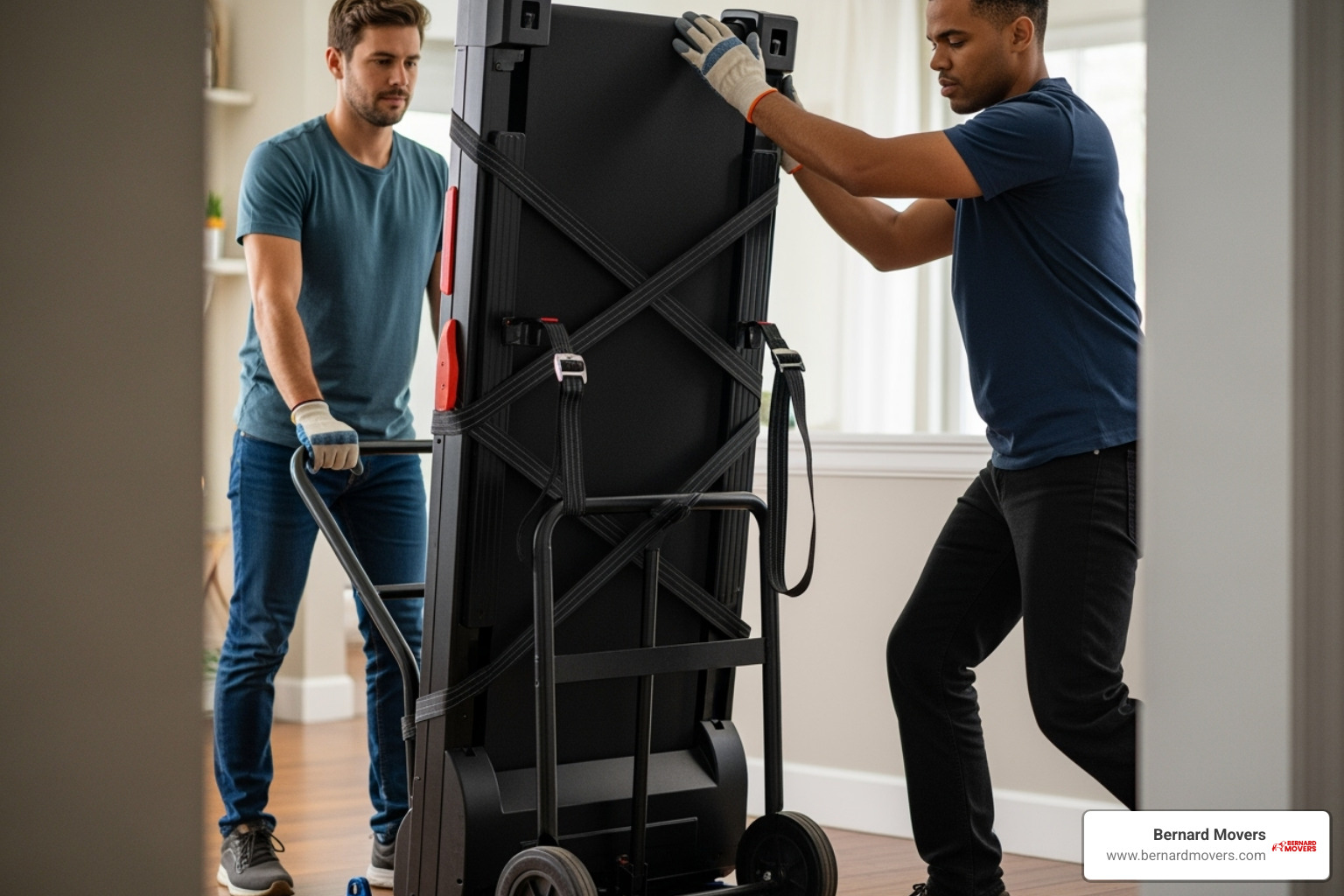How to move exercise equipment: Easy 2025
Your Game Plan for a Smooth Gym Move
How to move exercise equipment safely requires careful planning, proper tools, and the right techniques. Whether you’re relocating a single treadmill or an entire home gym setup, the process can feel overwhelming – but it doesn’t have to be.
Quick Answer: Essential Steps to Move Exercise Equipment
- Plan – Create inventory, measure equipment and doorways, gather tools
- Prep – Clean equipment, take photos, disassemble when needed
- Pack – Use sturdy boxes for weights, wrap parts in moving blankets
- Protect – Use dollies, furniture sliders, and floor runners
- Move – Lift with your legs, get help, secure everything in transit
Your home gym represents a significant investment in your health and wellness. With home fitness equipment becoming increasingly popular, protecting these valuable assets during a move is crucial.
The challenge? Some home gym equipment can weigh between 500 and 1,000 pounds. Moving a home gym can take 2+ hours of move time and 1-2 hours of prep time. Add in narrow Chicago hallways, walk-up apartments in Melrose Park, or tight stairwells throughout Illinois, and the task becomes even more complex.
But here’s the good news: with the right approach, you can relocate your fitness equipment safely and efficiently. This guide breaks down the entire process into manageable steps, from initial planning to final setup in your new space.
As Mina Georgalas, owner of Bernard Movers with nearly 30 years of experience, I’ve helped countless families across Chicago and Illinois understand how to move exercise equipment without damage or injury. Our team has developed proven techniques for handling everything from delicate electronics to massive weight stacks, ensuring your fitness investment arrives safely at your new home.

Quick look at how to move exercise equipment:
The Ultimate Guide on How to Move Exercise Equipment
Moving your home gym doesn’t have to be more stressful than your hardest workout. With the right approach and careful planning, you can relocate every piece of equipment safely and efficiently. Let’s break down how to move exercise equipment into manageable steps that will have you back to your fitness routine in no time.
Pre-Move Prep: Gathering Tools and Making a Plan
Success in moving exercise equipment starts long before you touch a single dumbbell. Think of this phase as your warm-up – it’s essential for preventing problems later.
Start by creating a detailed inventory of everything in your home gym. This helps you decide what’s worth moving versus what might be better sold or donated. An old, unused exercise bike, for instance, might be better left behind.
Before anything gets packed, give all your equipment a thorough cleaning and sanitizing. Wipe down machines with appropriate cleaners, wash gym towels on hot, and clean yoga mats with a vinegar solution. This prevents transferring germs to your new home and gives you a chance to inspect each piece for any damage.
Here’s where many people make a costly mistake: they forget to measure everything. Measure each piece of equipment, then measure all doorways, hallways, and stairwells in both your current and new homes. This is especially crucial in Chicago’s older buildings and narrow Melrose Park apartments, where tight spaces can complicate moving day.
The essential tools you’ll need include a furniture dolly for heavy items, moving blankets to prevent scratches, ratchet straps for securing equipment, and a basic toolkit for disassembly. Don’t forget labeled plastic bags for organizing small screws and bolts – you’ll thank yourself during reassembly.
Finding user manuals is crucial for safe disassembly and reassembly. If you’ve lost the originals, most manufacturers have downloadable versions on their websites. These manuals contain vital information about how to preserve your equipment’s life during a move.
Packing and Disassembly: A Guide for Different Equipment Types
Now comes the hands-on work. This phase requires patience, attention to detail, and a methodical approach.

Before you pick up a screwdriver, take photos from multiple angles. Documenting the disassembly process will be invaluable when you reassemble everything later. For complex weight machines, consider drawing simple diagrams of how cables run around pulleys.
As you disassemble each piece, labeling parts and cables becomes your best friend. Use masking tape and a permanent marker to label everything clearly. Organizing hardware in bags is essential. Use labeled zip-top bags and tape them directly to the corresponding equipment parts.
When packing small items like dumbbells and kettlebells, weight distribution is key. Avoid packing all your weights into one massive box. Instead, use sturdy plastic bins or multiple smaller boxes, wrapping each weight individually to prevent scratches and shifting.
Resistance bands and yoga mats need their own special attention. Roll mats tightly and pack them upright in tall boxes. Bands should go in individual bags to prevent tangling.
Treadmills require careful handling due to their weight and electronic components. Always unplug the machine first and secure the power cord. If your treadmill folds, lock it in the folded position according to the manual. The belt and deck are particularly vulnerable, so wrap the entire unit generously in moving blankets.
Ellipticals are notorious for their awkward shape and bulk. Most will need partial disassembly to fit through standard doorways. Remove handlebars, pedals, and the console if possible. The main frame will still be heavy, so plan on using a furniture dolly and having plenty of help.
Weight machines with weight stacks present the biggest challenge, as they can weigh 500 to 1,000 pounds. The golden rule here is removing weight stacks completely – never attempt to move the machine with weights still attached. Remove plates one by one, starting from the top, and pack them separately in sturdy containers.
The Move Itself: How to Move Exercise Equipment Safely
On moving day, proper technique and teamwork are critical for a safe move and preventing injury.

Proper lifting technique cannot be overstated when learning how to move exercise equipment. Always lift with your legs, not your back. Bend at the knees, keep your spine straight, and avoid twisting while lifting.
Enlisting helpers isn’t just recommended – it’s essential for anything over 50 pounds. Even for items you think you can handle, extra hands make the job safer and faster. For major pieces like treadmills or ellipticals, plan on having at least three people involved.
Using a furniture dolly transforms impossible tasks into manageable ones. Position the dolly, lift one end of the equipment onto it, then the other, and secure everything with straps before moving. Using furniture sliders can help you glide heavy items across floors without lifting, which is useful for protecting hardwood or tile.
Protecting floors with runners and padding doorways prevents costly damage to both your current and new homes. Protecting walls and doorways with moving blankets is equally important, especially in narrow Illinois hallways.
Navigating stairs requires extra caution and coordination. One person should always be at the bottom to guide and support, while others manage the weight from above. For multiple flights or heavy equipment, professional movers prove their worth.
Securing equipment in the moving truck is the final step before transport. Load heavy items first, towards the front of the truck. Use ratchet straps to secure everything to the truck walls, and use moving blankets between items to prevent damage.
Reassembly: Setting Up Your New Home Gym
Once your equipment is in your new home, the reassembly process begins.
Unloading safely requires the same careful techniques used for loading. Use dollies and avoid rushing.
Reassembling using photos and labels is where all that preparation pays dividends. Refer constantly to the pictures you took during disassembly. Start with main frames and gradually add components, using the correct hardware for each connection.
Checking all connections is crucial before you use any equipment. Double-check every bolt, screw, and cable connection. For machines with complex cable systems, ensure everything is routed correctly according to your diagrams or the user manual.
Testing equipment functionality should be done gradually. Start with the lowest settings for speed, incline, or weight. Listen for unusual noises and watch for any wobbling or instability. Test all safety features like emergency stops and safety keys before your first real workout.
Post-move safety checks include verifying that all safety mechanisms work properly and that the equipment sits level and stable on your new floors. Replace any components damaged during the move before using the equipment.
Planning the new gym layout requires thinking about workflow and safety. Ensuring proper equipment spacing means allowing at least 24 to 36 inches between machines for safe movement. If you want everything set up perfectly without the hassle, professional Exercise Equipment Assembly services can ensure optimal placement and safety.
DIY vs. Pro Movers: Deciding How to Move Exercise Equipment in Chicago
The big question is whether to DIY or hire professionals. The answer depends on several factors beyond just the cost.
Pros and cons of moving vs. selling your equipment is worth considering first. Moving keeps your familiar equipment, but it’s time-consuming, risky, and requires significant effort. Sometimes selling and buying new equipment at your destination makes more financial sense, especially for older items.
When to DIY makes sense for lighter equipment like dumbbells, resistance bands, or yoga accessories. If you’re moving locally within Chicago or Melrose Park, have plenty of strong helpers, and own the right moving equipment, you might handle smaller items yourself.
When to hire professionals becomes the smart choice for complex machines like treadmills, ellipticals, or multi-station home gyms. These items are heavy, valuable, and easy to damage without proper expertise.
Long-distance moves add complexity that professional movers handle better than DIY attempts. Chicago-specific challenges like walk-up apartments and narrow hallways in vintage Illinois homes require experience to navigate safely.
Assessing risk vs. cost means considering not just moving expenses, but the potential costs of equipment damage, personal injury, or damage to your home. Professional Moving Heavy Gym Equipment services provide expertise, proper equipment, and insurance that can save money in the long run.
At Bernard Movers, we have nearly 30 years of experience relocating exercise equipment throughout Chicago, Melrose Park, and across Illinois. We understand the unique challenges these moves present and have the tools and expertise to handle everything from delicate electronics to massive weight stacks.
Conclusion: Crossing the Finish Line of Your Gym Move
You now have a complete guide on how to move exercise equipment safely and efficiently. By breaking the process down into manageable steps, you can protect both your valuable fitness investment and your peace of mind.
Throughout this guide, we’ve covered the essential foundations: planning and safety at every stage. From creating detailed inventories and gathering the right tools, to taking photos during disassembly and using proper lifting techniques, each step builds toward a successful move. The careful attention to measuring doorways, protecting floors, and securing equipment in transit ensures your gear arrives in perfect condition.
However, we understand the reality many Chicago and Illinois residents face. The physical demands of moving 500-pound weight machines through narrow hallways or up tight stairwells in Melrose Park walk-ups can be overwhelming, making a DIY approach impractical.
This is where professional expertise provides genuine peace of mind. At Bernard Movers, our nearly 30 years of experience relocating fitness equipment across Chicago means our team has the specialized dollies, materials, and knowledge to navigate the area’s unique housing challenges safely.
We understand your home gym is a commitment to your health. Our approach focuses on a stress-free relocation, letting you settle into your new home without worrying about damaged equipment or injuries.
Whether you’re moving across town or taking advantage of our 20% additional discount on moves to Georgia and Florida (booked for delivery by March 15, 2025), careful planning and experienced handling make all the difference.
Let our expert Fitness Equipment Mover team handle the heavy lifting for you, so you can focus on what matters most – getting back to your fitness routine in your new home.